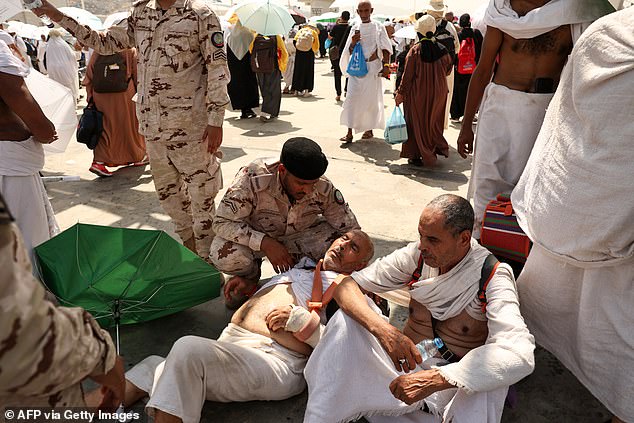The death toll from the hajj pilgrimage has reportedly surpassed 1,000, as a brutal heatwave has brought temperatures soaring above 50C at the world’s largest gathering of Muslims in Saudi Arabia.
Horrifying images show bodies covered and abandoned in the street after falling victim to the high temperatures, while many others suffered severe heat stroke and had to be urgently brought indoors.
Unregistered pilgrims account for more than half of those who have died, and many of them have been unable to access air-conditioned facilities or help from authorities.
The new deaths reported today include 58 from Egypt, according to an Arab diplomat who provided a breakdown showing that of that country’s total of 658 deaths, 630 were unregistered.
A British imam described the scenes as “heartbreaking” and said it was impossible for pilgrims to walk the streets and not see people suffering from the heat.
A man, affected by the scorching heat, is helped by a member of the Saudi security forces as Muslim pilgrims arrive to perform the symbolic ‘stoning of the devil’ ritual during the annual haj pilgrimage in Mina on June 16, 2024.
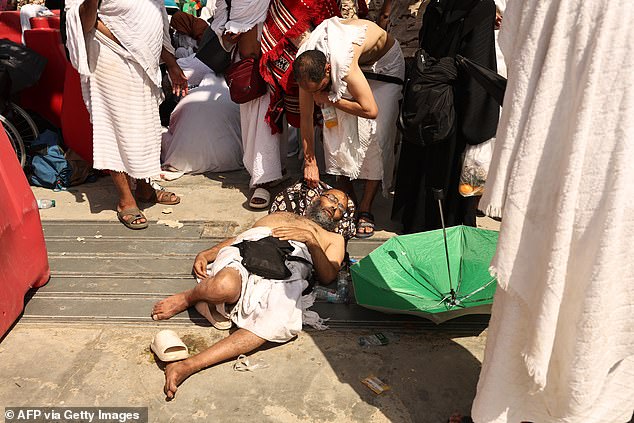
A man, apparently suffering from heat stroke, receives help from another Muslim pilgrim earlier this week.
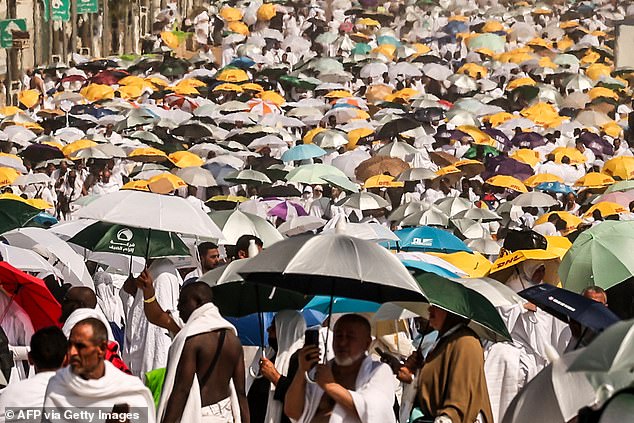
Muslim pilgrims use umbrellas to protect themselves from the sun as they arrive at the base of Mount Arafat, also known as Jabal al-Rahma or Mount of Mercy, during the hajj pilgrimage.
“There are many, many stories from the pilgrims who are with me about what they saw on the streets, particularly last Sunday,” he told the BBC on Sunday.
‘While walking, you couldn’t walk 20 meters unless you saw someone struggling in the heat.
“People did everything they could to protect themselves, they drank water from kind people who gave them towels, they took shade in hotel receptions.
“It was heartbreaking at times, I have never seen so many people fight collectively.”
He went on to say that while authorities were available to help, they need to learn lessons from the horrific scenes caused by extreme heat, compounded by overcrowding.
About 1.8 million pilgrims took part in the hajj this year, 1.6 million of them from abroad, according to Saudi authorities.
Every year, tens of thousands of pilgrims attempt to perform the hajj through irregular channels, as they cannot afford the often expensive procedures to obtain official hajj visas.
This puts these unregistered pilgrims at risk as they cannot access the air-conditioned facilities provided by the Saudi authorities along the Hajj route.
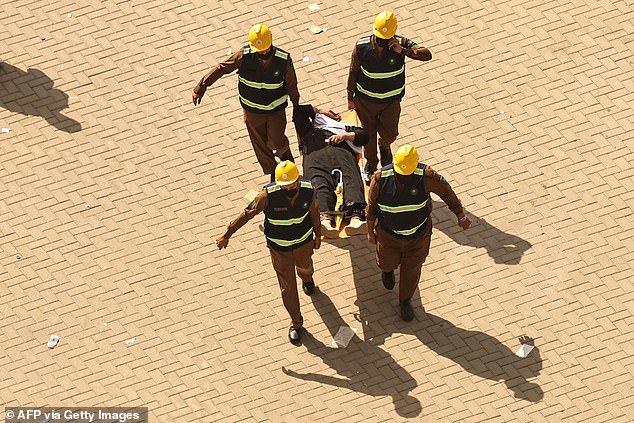
Lifeguards carry a man affected by the scorching heat on a stretcher
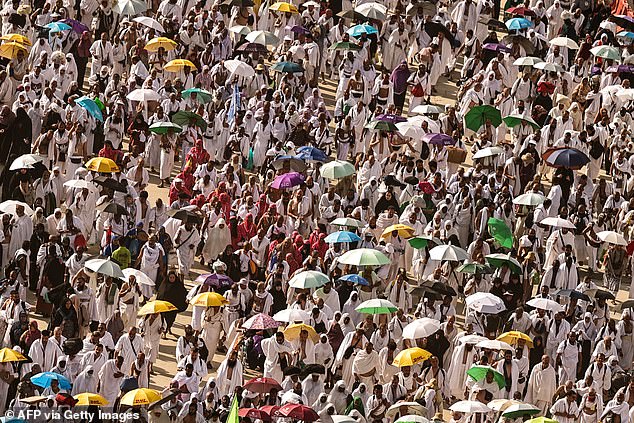
About 1.8 million pilgrims participated in the Haj this year, 1.6 million of them from abroad, according to Saudi authorities.
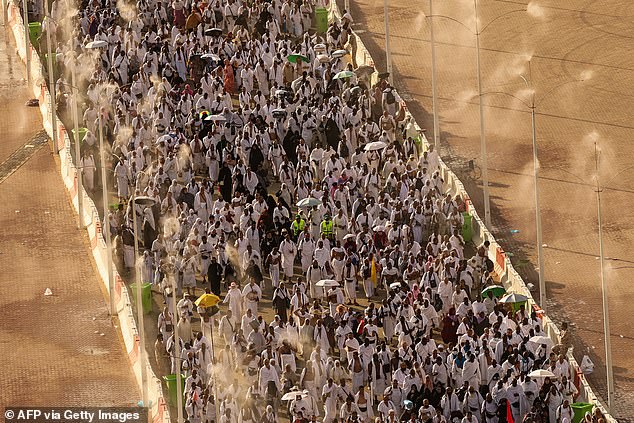
Muslim pilgrims walk under mist dispensers, which Saudi authorities have installed to try to keep people cool.
“I think the Saudi authorities perhaps need to start thinking about controlling the number of pilgrims who come each year,” the British imam said.
“With climate change and the fact that the pilgrimage takes place in the summer months, it is really necessary to study this in more detail.”
The pilgrimage is increasingly affected by climate change, according to a Saudi study published last month that said temperatures in the area where the rituals take place were rising by 0.4 degrees Celsius (0.72 degrees Fahrenheit) every decade.
Temperatures reached 51.8 degrees Celsius (125 Fahrenheit) at Mecca’s Grand Mosque on Monday, the Saudi national meteorological center said.
Saudi officials had advised pilgrims to use umbrellas, drink plenty of water and avoid exposure to the sun, and curfews were reported to have been put in place in the camps to tell people not to leave their tents during the hottest hours. of the day.
But many of the Hajj rituals, including prayers on Mount Arafat that took place on Saturday, involve being outdoors for hours during the day.
Fortunately, in the coming years the Hajj, whose date is moved forward by 11 days each year in the Islamic calendar, will be celebrated in winter, when temperatures are milder.
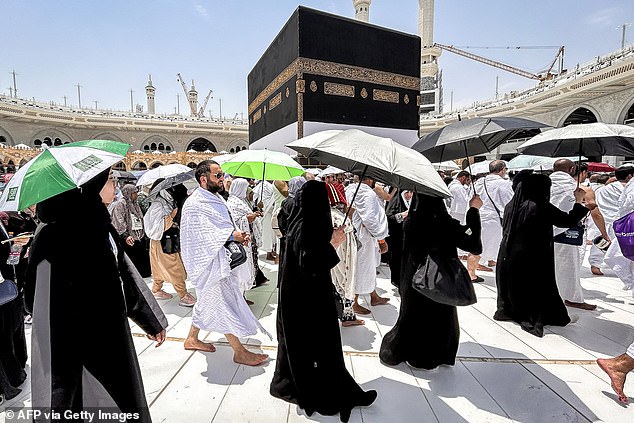
Muslim devotees walk around the Kaaba, Islam’s holiest shrine, at the Grand Mosque in the holy city of Mecca in Saudi Arabia on June 13, 2024.
Every year there are deaths of pilgrims, not only due to the heat but also due to the difficulty of the walk and the large number of people who do it.
The deadliest incident ever recorded at the pilgrimage occurred in 2015, when a stampede at the Mina camp killed more than 2,400 pilgrims. Saudi Arabia has never acknowledged the full cost of the stampede.
Another crane collapse at the Grand Mosque in Mecca, which preceded the Mina disaster, killed 111 people.
The second deadliest Hajj incident was a stampede in 1990 that killed 1,426 people.

